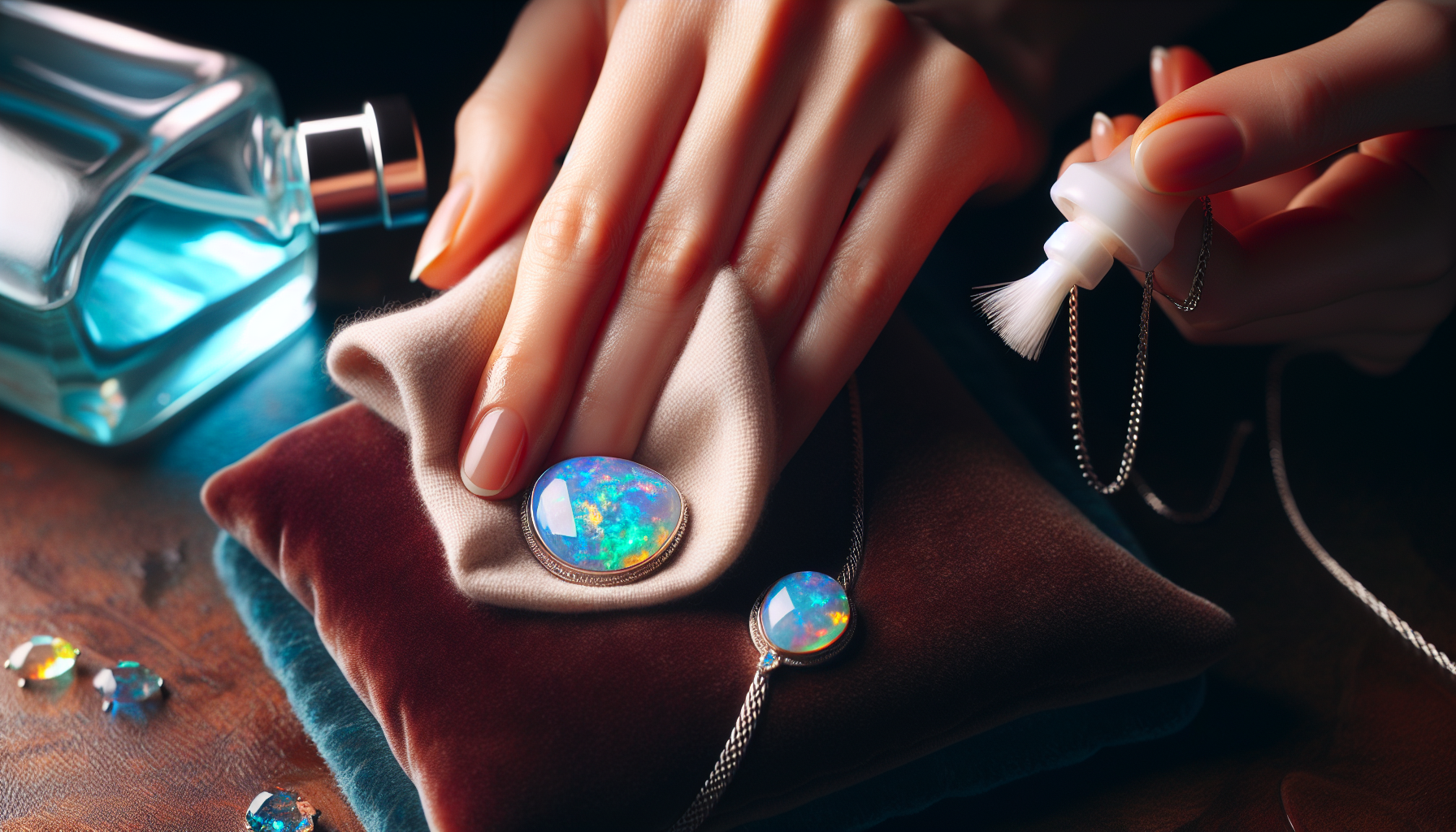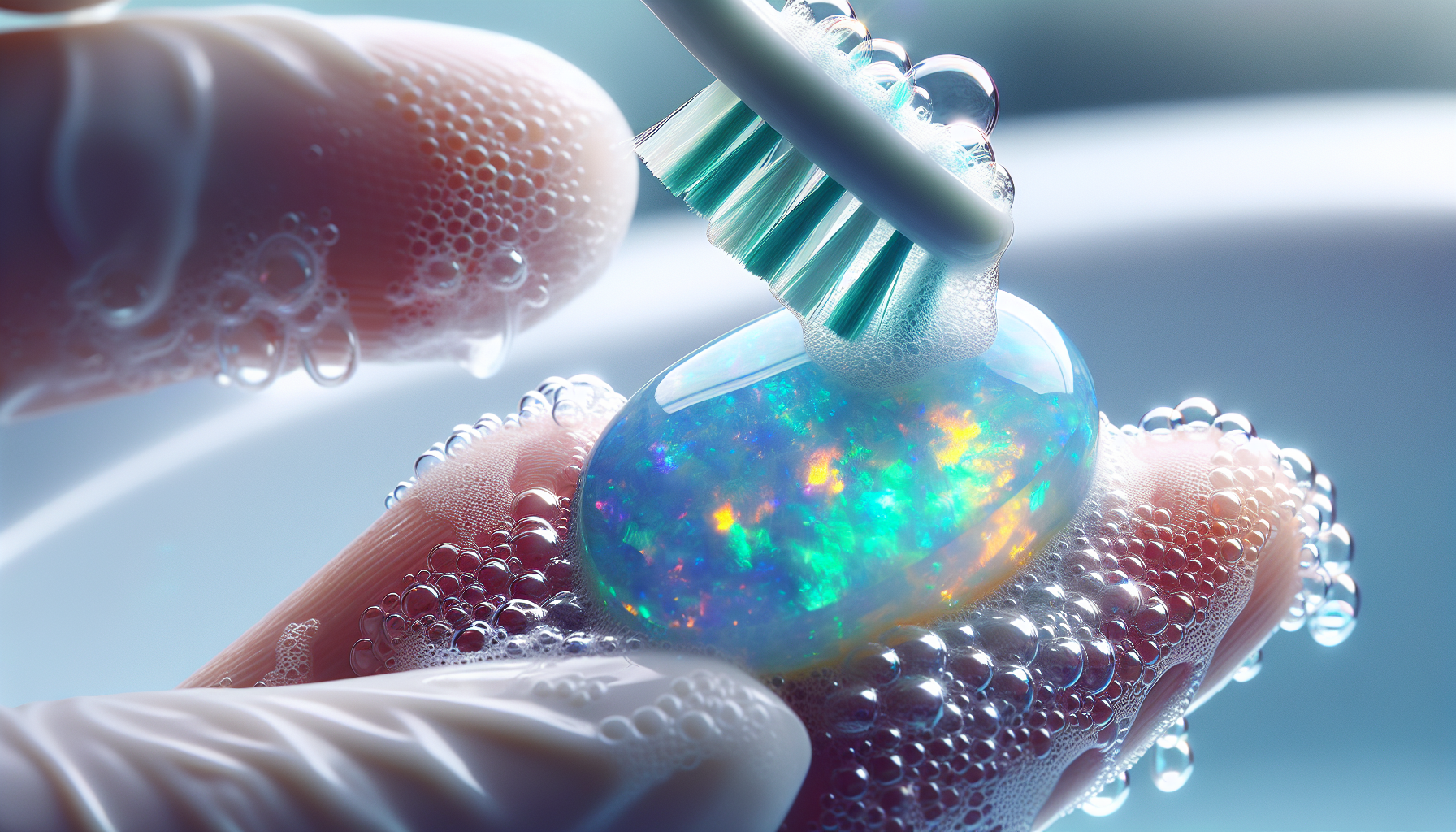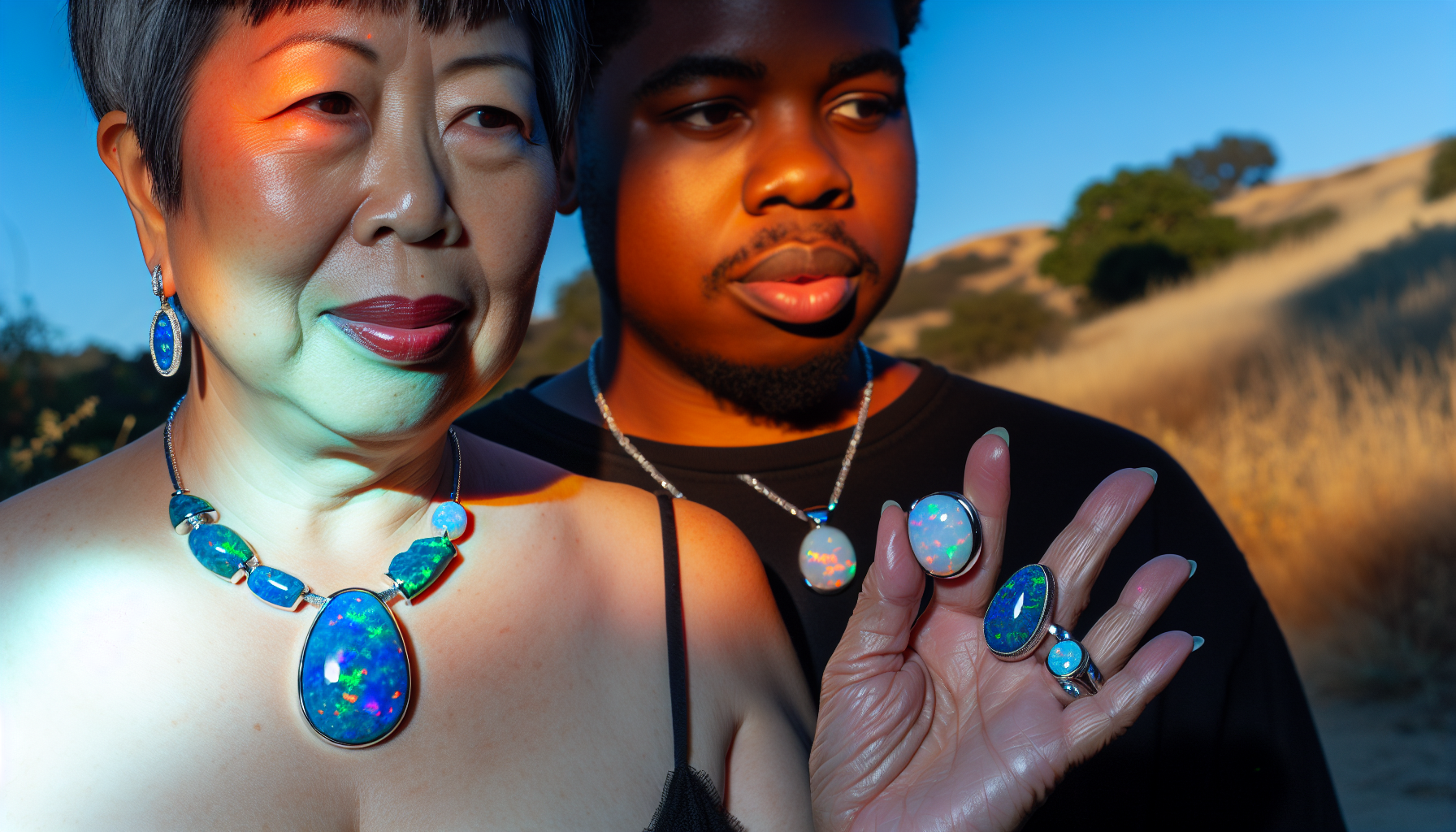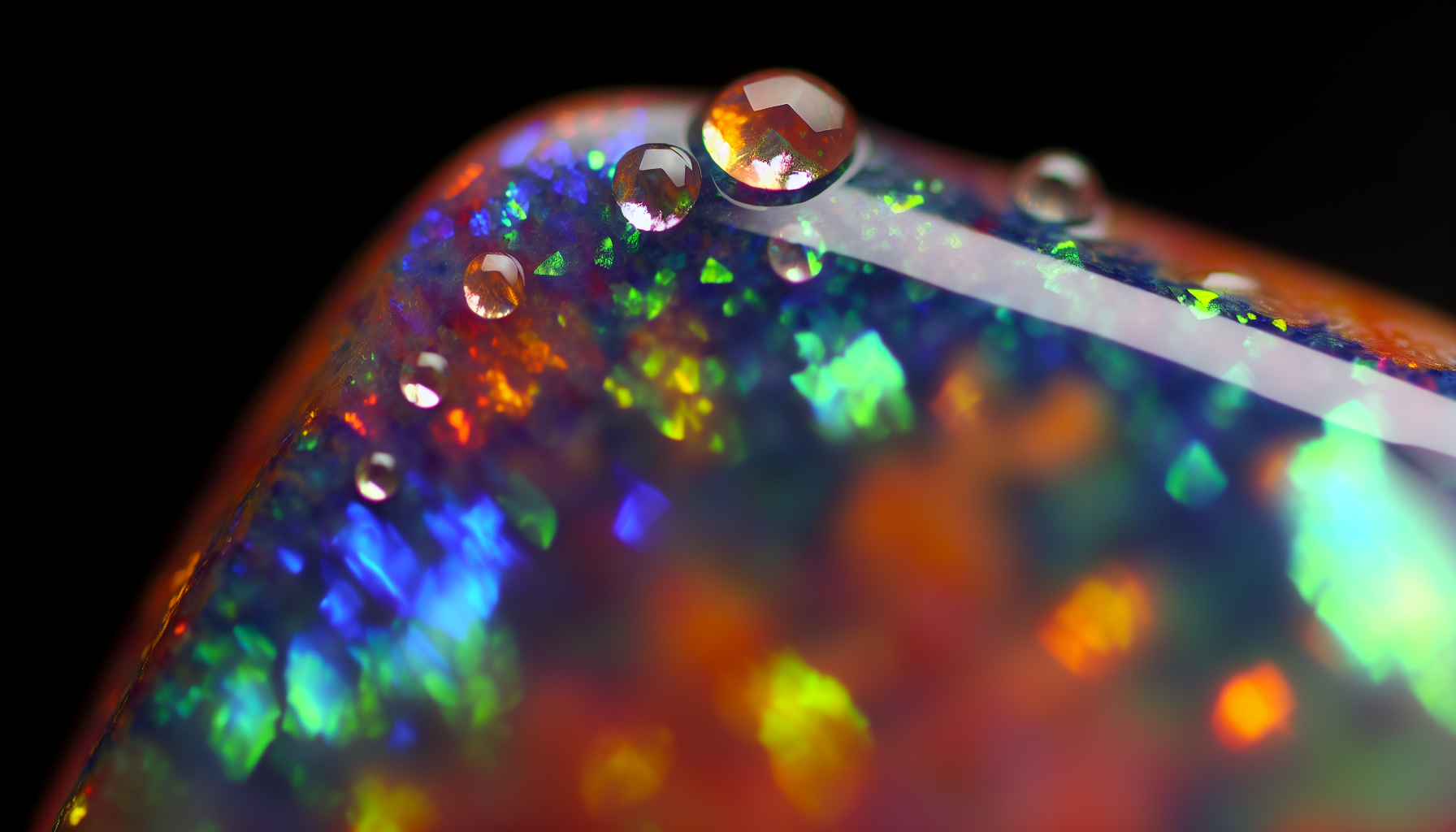Opal jewelry is resilient to occasional accidental splashes of water, but should be removed before engaging in activities with prolonged exposure. Clean opals with a mild detergent and soft cloth or toothbrush. Avoid the use of bleach, chemicals and abrasive cleaners. Store opals at 50% humidity for best results – padded fabric bags offer short term storage while cotton wool stored in a sealed plastic bag works well for long term storage.
Opals, those mesmerizing gemstones that display a myriad of colors as they catch the light, have been cherished and admired for centuries. But did you know that these precious stones have a unique relationship with water? Yes, beneath their shimmering surface, opals are more than just a feast for the eyes. They are a complex blend of silica and water that responds in surprising ways to the environment around them. This unique attribute raises some important questions when it comes to caring for your opal jewelry, such as “can opal go in water?” How do they interact with water? Can they be damaged by exposure to different types of water or environmental conditions? And importantly, how can we ensure they continue to dazzle for years to come?
Is Opal Water Safe?
Opals should not be submerged in water, especially for extended periods, to avoid potential damage.

Opals, with their fiery play of colors and captivating allure, are surely a sight to behold. But are opals water-resistant? Well, it varies. Solid opals, for example, are quite durable and can withstand minor water exposure. They can comfortably weather the occasional splash without losing their luster. However, if your opal jewelry, such as earrings or a fire opal ring, finds itself in a swimming pool or the shower, it’s a different story. Chemicals found in pools, soaps, and lotions could damage your cherished gemstones. Hence, it’s advisable to take off your opal jewelry before immersing in these water-filled settings.
What about the effects of various forms of water or elements on opals? Let’s analyze the impact of saltwater, tap water, sunlight, and salt.
Can Opal Go In Salt Water?
No, opals should not go in salt water as it can dehydrate and damage the stone.
While the image of sparkling opal earrings glinting in the sunlight as you take a dip in the ocean might be appealing, it’s best to leave your opals on the shore. The potentially damaging effects of salt and chemicals in sea water on opals, especially rough opal stones, can lead to:
- dehydration
- disintegration
- loss of moisture
- stone breaking apart
- loss of vibrant play of colors and transparency
- dull or clear appearance
Over time, this exposure can also lead to a loss of the opal’s vibrant play of colors and transparency, leaving it looking dull or clear. So, if you’re planning a beach vacation, ensure your opal jewelry is safely stored away from the salty breeze!
Can Opal Go In Tap Water?
Solid opals can generally withstand brief exposure to tap water, but opal doublets and triplets may be damaged.

Tap water, which we often consider harmless, is generally safe for our precious opals. Whether you’re washing dishes or your hands, your Australian opal can handle a bit of tap water exposure without any damage. However, while solid opals can withstand water, opal doublets and triplets have a different tale to tell. These opal varieties consist of multiple layers glued together, and exposure to water can cause the glue to deteriorate over time.
So, it’s best to clean these delicate beauties with a damp soft cloth and mild detergent, avoiding soaking or immersing them in water. Remember, akin to us, opals also need a bit of care and attention to maintain their radiance!
Can Opal Go In the Sun?
Opals can enjoy sunlight but should avoid prolonged exposure to prevent damage.

Sunlight, the giver of warmth and light, is generally safe for opals. They love to bask in its glow, revealing their vibrant play of colors. However, opals are not fans of extreme temperature changes or high temperatures. So while your opal can enjoy a sunny day, it’s best to avoid prolonged exposure to intense sunlight or hot lamps to prevent potential cracking.
The opal’s natural structure, composed of hydrated silicon dioxide, can be altered if exposed to such harsh conditions, leading to cracking and other damage. So, while your opals undoubtedly love the sun, remember to:
- Protect them from the intense midday sun
- Store them in a cool, dry place when not wearing them
- Avoid exposing them to harsh chemicals or cleaning agents
- Handle them with care to prevent accidental damage
By following these tips, you can maintain the sparkling beauty of your opals for years to come.
Can Opal Go In Salt?
Opals and salt don’t mix well. Salt can scratch and damage the delicate surface of the stone.
Salt, the humble kitchen staple, can be a tricky element for opals. While it doesn’t directly harm opals, it’s best to avoid abrasive materials like salt when cleaning or handling opal jewelry to prevent any scratches. Prolonged exposure to salt or saltwater can cause cracking or discoloration, particularly in hydrophane opals that can absorb water.
So, the next time you’re cooking with salt, remember to take off your opal ring to ensure its safety and sparkle!
Understanding Opal’s Relationship with Water

After examining how various types of water and elements impact opals, let’s analyze further and understand the science behind opals’ interaction with water. We’ll uncover why opals behave the way they do when exposed to water and how their unique structure influences their interaction with water.
We’ll also analyze the differences between solid opals and opal doublets and triplets, and how each type responds uniquely to water exposure. Gear up for an intriguing exploration of opals and water!
The Science of Opal and Water
The unique structure of opal forms the crux of its relationship with water. Opal is a form of quartz that contains water molecules entrapped within its structure. When opal is exposed to water, these water molecules interact with the silica in the opal, resulting in alterations in its physical and optical properties. Opals are very precious and valuable stones. On average, they generally contain 5-6% water. So when they’re exposed to water, they can absorb it, leading to changes in color and the play-of-color effect that opals are famous for.
However, this interaction with water can also lead to issues, causing the opal to crack if it loses water quickly. Understanding this unique relationship between opals and water is key to preserving the beauty and longevity of these precious gemstones.
Solid Opal and Water Exposure
Solid opals, as their name implies, are composed entirely of natural opal. This makes them more resilient to water exposure. They can comfortably weather the occasional splash or even a short soak without losing their luster. However, these strong and resilient gemstones, such as Australian opals, have their kryptonite – dry conditions or rapid temperature changes.
When exposed to such conditions, solid opals, despite their hardy nature, may crack due to the high amount of water they contain. This clearly shows that even the most durable gemstones need some tender loving care occasionally!
Special Considerations for Opal Doublets and Triplets
Opal doublets and triplets are a different story altogether. Unlike solid opals, these varieties consist of multiple layers glued together, making them more susceptible to water damage. The glue used in these opals may deteriorate when exposed to water, leading to lifting between the layers, including the third transparent layer in triplets. This can result in the opal taking on a ‘foggy’ or grey appearance.
Hence, if you possess opal doublet or triplet opal jewelry, ensure to handle them with utmost care, particularly near water.
Best Practices for Wearing Opals Around Water
Having analyzed the unique interaction between opals and water, let’s discuss how to apply this knowledge practically. How do we wear and care for our opals around water to ensure they continue to shine brilliantly for years to come? Whether it’s everyday wear, handling accidental splashes, or dealing with prolonged water exposure, this section will provide you with practical tips and guidance to help you care for your opals.
Everyday Wear and Accidental Splashes
In everyday life, opals can cope with a bit of water. An accidental splash while washing your hands or a surprise rain shower isn’t likely to harm your opal jewelry. However, in the event of such an unexpected dousing, simply pat your opal dry with a soft cloth to remove any excess water and let it air dry naturally in a cool, dry place.
Keep in mind, the secret is to handle your opal delicately and avoid subjecting it to drastic temperature variations or aggressive chemicals, treating it with the care you would give to a thin slice of a delicate material.
Prolonged Exposure to Water
When it comes to prolonged exposure to water, such as swimming or bathing, it’s best to remove your opal jewelry beforehand. Extended exposure to water can cause the adhesive in opal doublets and triplets to deteriorate, leading to lifting between the layers. Plus, harsh chemicals present in pools, soaps, and lotions can cause further damage to your opals.
Hence, even if your opal is your lucky charm, it’s advisable to leave it ashore while you swim!
How to Cleanse Opal Jewelry Safely?
Opals, with their vibrant hues and captivating charm, certainly warrant the finest care. And part of that care involves knowing how to clean them properly. How do you cleanse your opal jewelry without causing any damage? Can you use soap and water, or do you need a special cleanser?
Let’s examine the do’s and don’ts of opal cleaning, including the delicate Ethiopian opal, to ensure your gemstones maintain their radiant shine.
Using Mild Detergent and a Soft Toothbrush
When it comes to cleaning your opals, simplicity is key. A mild detergent, warm water, and a soft toothbrush or cloth are all you need to keep your opals clean and sparkly. Gently clean the opal with the detergent-water solution, being careful not to scrub too hard.
Rinse thoroughly and pat dry with a soft cloth. This straightforward yet efficient method can help preserve the aesthetics and durability of your opals.
The Do’s and Don’ts of Opal Cleaning
While cleaning your opals, there are a few things to keep in mind:
- Avoid Harsh Chemicals: Bleach, chemicals, and abrasive cleaners can cause irreversible damage to both your opals and other surfaces they may come into contact with.
- Stay Away from Ultrasonic and Steam Cleaners: The intense heat and vibrations from these devices can cause your opal to crack or become discolored.
- Seek Professional Help for Damage: If your opal loses its shine or gets scratched, consider consulting a professional. An opal cutter can polish your opal, restoring its natural shine and splendor.
By adhering to these simple guidelines, you can ensure your opals retain their sparkle as on the day you acquired them!
Storing Opals: Keeping Them Safe from Water Damage
Proper storage of your opals is just as important as proper cleaning. How you store your opals can greatly affect their longevity and luster. So, what’s the best way to store your opals to protect them from water damage?
Whether it’s a short-term storage solution or a long-term one, we’ve got you covered.
Short-Term vs. Long-Term Storage Solutions
For temporary storage, a padded fabric bag offers a soft and cushioned setting that helps safeguard your opals from scratches and impacts, while keeping them dust-free.
For long-term storage, opals should be stored in cotton wool with a few drops of water, then placed into a sealed plastic bag. This creates a controlled environment that helps to preserve the opal’s beauty and durability over time. Remember, even the most robust gemstones require periodic tender loving care!
Ideal Humidity Storage Safes and Alternatives
Maintaining the perfect humidity level is crucial when it comes to storing opals. Opals should ideally be stored at a humidity level of approximately 50%. Using a dehumidifier or humidifier to maintain this optimal humidity range is one option. Alternatively, wrapping the opal in cotton wool with a few drops of water and placing it in a plastic bag may also help maintain the ideal humidity level.
This is especially important in very low humidity environments, which can cause the opals to become brittle due to the loss of water content, making them opal wet.
Repairing Water-Damaged Opals
Accidents occur. Despite your utmost efforts, your opal may get exposed to water and suffer damage. But don’t despair just yet. There’s still hope for your precious gem. From spotting signs of a cracked or water-damaged opal to investigating restoration options, this section will guide you through the process of restoring your opal to its previous splendor.
Identifying Signs of a Cracked Stone
If your opal has been exposed to water and you suspect it’s damaged, the first step is to identify signs of a cracked or damaged opal:
- Uneven or Inconsistent Color: Hold the opal up to a light source. If the colors appear uneven or inconsistent, it might indicate damage.
- Cloudiness or Foggy Appearance: A cloudy or foggy appearance within the stone can be a sign of water damage.
- Internal Lines: Look for internal lines that reflect light differently than the rest of the opal, as this may suggest the presence of cracks.
- External Cracks: Feel the surface of the opal with your hand. External cracks that can be felt are a clear indication of damage.
Bear in mind, the earlier you detect the damage, the higher the chances of restoring your opal to its former beauty.
Restoration Options for Water-Affected Opals
Once you’ve identified the damage, the next step is to explore restoration options. A professional lapidary can examine the opal and potentially polish it while keeping it cool with water. Soaking the opal in distilled water for a short period may also help remove any impurities or debris that may have caused the water damage.
However, not all home treatments may be effective, and there is a risk of further damaging the opal. Hence, it is always recommended to seek advice from a professional jeweler or gemologist for the best restoration technique for your specific opal.
Summary
In conclusion, opals are truly a marvel of nature with their beautiful play of colors and unique relationship with water. While they can handle a bit of water, special care needs to be taken to protect them from damage. Whether it’s removing your opal jewelry before swimming, cleaning them with a soft cloth and mild detergent, or storing them properly in a humid environment, every little bit helps in preserving the beauty and longevity of these precious gemstones. Remember, your opal is more than just a piece of jewelry. It’s a testament to the wonders of nature, a symbol of beauty and elegance, and with the right care, it can continue to shine brilliantly for years to come.
Frequently Asked Questions About Opal In Water
Can you wear opal jewelry in the shower?
It is recommended to remove Opal jewelry before exposing it to water and other chemical contaminants, such as chlorine or shampoo. This will help to protect the Opal and mitigate any potential damage that could occur from wear and tear.
Can I wear opal everyday?
Opal can be worn daily if given adequate care and consideration, especially when worn as an Opal necklace, earrings, or brooch. However, be gentle with your jewelry to ensure daily wear is safe.
Can I wash my hands with an opal ring on?
It is not recommended to wash your hands with an opal ring on as it could lead to contamination and residue left in the opal.
Do opals change color when wet?
Hydrophane opals have the ability to absorb water, causing them to temporarily change color and lose their play-of-color. However, once air-dried, the original appearance of the opal will return.
Can opals be damaged by water?
Solid opals can generally handle some water, however opal doublets and triplets may be more prone to damage due to their construction. Prolonged exposure to water can deteriorate the adhesive between the layers and cause lifting.